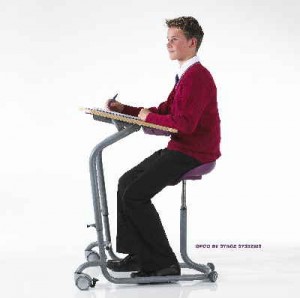
As Chair of the charity Pain UK, and as a former trustee and (interim) CEO of the national charity BackCare, I have spent many years campaiging to improve children’s physical wellbeing at school.
I wrote this article for Century 21 Schools shortly after setting up Stakeholder Design. At the time of writing I was on a three month tour of the world’s most innovative learning environments.
“Sometimes the most amazing thoughts strike in the strangest of places. Archimedes had his Eureka moment in the bath. Newton had his sitting under an apple tree. Now I’m having one. I’m sat in an airplane somewhere over the Gobi desert and all I can think of is how, from a child’s perspective, schools and airplanes are much the same.
Think about it. I arrived at a time decided by others rather than me. I had a list of prohibited articles that I could not take through the security cordon (the school gates). I ate at the same time as everyone else. I took my place at a pre-assigned seat where, unable to escape, I concentrated mostly on the sense of discomfort that the seat was giving me. Airplane seats seem to be designed solely around squeezing people in and keeping prices low. I find myself thinking that this is also true of the furniture we choose for schools.
The early Victorians, who invented our approach to schools, didn’t have petroleum based plastic, extruded metals, injection mouldings and production lines. Indeed, when they began to expand access to education, they were still an agrarian society. Children were given time off at Easter and Summer to help with planting and harvesting. Freed from the constraints of mass manufacture, unit profits and re-sale, their furniture was optimised around factors like utility, comfort, lifespan and waste-reduction. It was a sustainable approach and it was also, in terms of ergonomics, much more advanced than our own.
There is no animal on Earth that chooses to sit with a straight back, a right-angled bend at the hips and a right-angled bend at the knee. The only reason why we do it is because it makes it cheaper to produce and transport furniture. Indeed, while children are on average four inches taller than they were fifty years ago, furniture is on average eight inches shorter. The reasons have nothing to do with ergonomics.
160 years ago, furniture was designed around what is actually going on in your back as you sit. A higher seating base was used – one that has a sixty degree bend at the knee, much as one would have while sitting on a horse. This allows the leg to take some of the weight of the body (which is what they are designed to do) and relieves pressure on the lower back, which is otherwise unnaturally bent and placed under the weight of the whole upper body.
Desks show similar levels of forethought. The sloping desks used at that time allowed everyone to find a natural height at which to rest their elbows. They also reduced strain on the back by enabling a much more upright reading position. Try reading anything that is sitting on a horizontal surface. The only way to do it is to tip the head forward of the body, imposing a heavy weight on the upper vertebrae. This imposes a similar physical strain to trying to hold a bag of potatoes six inches forward of the body while trying to learn something.
Today, our children sit on seats designed for short-term use and optimised around the needs of the buyer. Bursars are attracted to plastic seats because they are cheap to buy and light enough to put on top of tables at the end of the day, thus reducing cleaning costs.
Outside of schools, the plastic seats that we force our children to use are mostly seen in places like village halls and waiting rooms. They are typically used once a week for up to an hour, supporting community activities like book-clubs, scout meetings and the Women’s Institute. Between uses, they are stacked up in a corner, or arranged around the room so that people can use the space in the m It was for these reasons that the Robin Day plastic chair has come to be seen as a design classic. However, when it is put into schools, its many attributes become massive failings.
Between the age of five and sixteen, children will spend around 12,000 hours sat on a chair intended for short term occasional use. Sitting on these chairs is inherently distressing, such that anyone spending more than 20 minutes on one will be hard pressed to remain focused on anything other than their bottom. As the body struggles to remain balanced, pressure on the lower back leads to slouching. This in turn compresses the lungs, making it harder to draw in sufficient oxygen to concentrate (this is made even worse in hermetically sealed classrooms, where the oxygen level is typically similar to that of – surprise, surprise – an airplane). How sad that financial cost rather than educational value should carry the day. Plastic chairs are undermining the ability of children to study and, quite possibly, damaging their long term health.
Next time you’re thinking about buying furniture for use by students at your school, ask yourself this question: is there anyone in the country who would swap their office chair for a plastic seat and not expect to see a reduction in performance?

Would you? Why, then, do we ask our children to devote so much time to learning and then undermine their efforts by making them use furniture that all of us would reject as inherently unsuitable?
In The Apprentice, Lord Sugar gets a special seat indicating that he is the most important person in the organisation. But it seems morally repugnant (and strategically inept) to take this attitude in a school. Children are the most important people in any school. Their needs should never take second place to the wants of those who manage them.
Most of the problem with furniture in British schools arises from the fact that children are unable to move during lessons. Convention says that classrooms have to look a certain way. But the fact is that over 80% of all the furniture, fixtures and fittings in a classroom can be moved or replaced on an ad hoc basis. If the process changed so that children could bend, stretch and recover during lessons, we might be able to carry on with plastic chairs. If not, then doing something as simple as buying Back Care’s seat wedge can change the shape of the seat to relieve pressure on young backs.
A sage was once asked what is the most comfortable position to sit in. “The next one,” he replied. Back on the airplane, I’m thinking that the guy up front probably has a better seat than me. Squirming from one position to the next, I reflect that all I have to do is pass the time until I can get out of this space. I wonder how many children I’ve flown over, and how many of them think the same in school every day.”
Facts about children and back pain:
- 21% of children experience backpain by age 16. 15% of children under age 16 seek medical attention to deal with it.
- A typical carry-load for a Year 7 girl can be over 20% of her body weight. Doctors recommend 10-15% as a maximum for adults.
- Plastic seats are designed around a 90 degree bend at the waist and knee. It is physically impossible to sit in this manner without stressing the lower back.
- Children are now on average four inches taller than their 1950s counterparts. Yet furniture is now typically eight inches lower. This increases pressure on the lower back.
- Books placed on horizontal desks can only be read by leaning forward. Doing so puts stress on the neck as it requires the person to suspend an 8lb weight (the head) in space in front of their shoulders.
- The focal distance of a child is much shorter than that of an adult. This encourages them to lean forward even more.
- Research conducted in Finland showed that height adjustable furniture led to significantly improved pass rates (ie fixed height furniture can reduce pass rates).
- UK spending on school furniture is 10% of the EU average.
- According to the British Educational Suppliers Association, “No EU country will purchase typical UK manufactured fixed height school furniture”.
- A child sat on a plastic seat will typically begin to feel discomfort within 15 minutes. After that point it is a battle between the teacher and the furniture to hold the child’s attention.
- Sitting higher with a sloping desk improves both posture and ability to learn